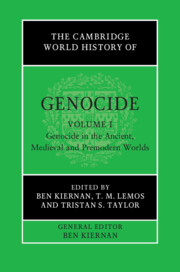Book contents
- The Cambridge World History of Genocide
- The Cambridge World History of Genocide
- The Cambridge World History of Genocide
- Copyright page
- Contents
- Figures
- Maps
- Tables
- Contributors to Volume I
- General Editor’s Acknowledgements
- General Editor’s Introduction to the Series
- Introduction to Volume I
- Part I Themes of Genocide through History
- Part II The Ancient World
- Part III The Medieval World and Early Imperial Expansions
- 15 William the Conqueror’s Harrying of the North, 1069–1070
- 16 Genocidal Massacres of Jews in Medieval Western Europe, 1096–1392
- 17 Crusaders and Mass Killing at Jerusalem in 1099
- 18 The Albigensian Crusade and the Early Inquisitions into Heretical Depravity, 1208–1246
- 19 Mongol Genocides of the Thirteenth Century
- 20 Việt Nam and the Genocide of Champa, 1470–1509
- 21 Genocidal Massacres in Medieval India
- 22 Mass Extermination in Prehistoric Andean South America
- 23 The Spanish Destruction of the Canary Islands
- 24 Genocidal Massacres in the Spanish Conquest of the Americas
- Index
24 - Genocidal Massacres in the Spanish Conquest of the Americas
Xaragua, Cholula and Toxcatl, 1503–1519
from Part III - The Medieval World and Early Imperial Expansions
Published online by Cambridge University Press: 23 June 2023
- The Cambridge World History of Genocide
- The Cambridge World History of Genocide
- The Cambridge World History of Genocide
- Copyright page
- Contents
- Figures
- Maps
- Tables
- Contributors to Volume I
- General Editor’s Acknowledgements
- General Editor’s Introduction to the Series
- Introduction to Volume I
- Part I Themes of Genocide through History
- Part II The Ancient World
- Part III The Medieval World and Early Imperial Expansions
- 15 William the Conqueror’s Harrying of the North, 1069–1070
- 16 Genocidal Massacres of Jews in Medieval Western Europe, 1096–1392
- 17 Crusaders and Mass Killing at Jerusalem in 1099
- 18 The Albigensian Crusade and the Early Inquisitions into Heretical Depravity, 1208–1246
- 19 Mongol Genocides of the Thirteenth Century
- 20 Việt Nam and the Genocide of Champa, 1470–1509
- 21 Genocidal Massacres in Medieval India
- 22 Mass Extermination in Prehistoric Andean South America
- 23 The Spanish Destruction of the Canary Islands
- 24 Genocidal Massacres in the Spanish Conquest of the Americas
- Index
Summary
This chapter examines and compares three genocidal events in the early modern Caribbean and Mesoamerica: the massacres of Xaragua (Hispaniola, 1503), Cholula (Mexico, 1519), and Toxcatl (Mexico, 1520; also known as the Massacre of Templo Mayor). Each of the three mass killings marked a political and military turning point in the history of Spanish military expansion in the Americas. They share other important characteristics, too. These massacres were entirely or partially planned and executed by European actors, namely Spanish officials and military entrepreneurs (conquistadores) under the leadership of fray Nicolás de Ovando, Hernán Cortés and Pedro de Alvarado respectively. Each event can be described as a genocidal massacre targeting a specific community because of its membership of a larger group: the primary objective of the European perpetrators was to provide an object lesson for the surviving members of that group (Leo Kuper). In each case, European perpetrators sought to avoid scrutiny and censure from within their own group by explaining and justifying their actions as a pre-emptive strike against indigenous plots. The tangible involvement of indigenous actors — altogether crucial in the case of the Massacre of Cholula ax— further complicates the historical analysis of a complex sources.
Keywords
- Type
- Chapter
- Information
- The Cambridge World History of Genocide , pp. 622 - 647Publisher: Cambridge University PressPrint publication year: 2023



